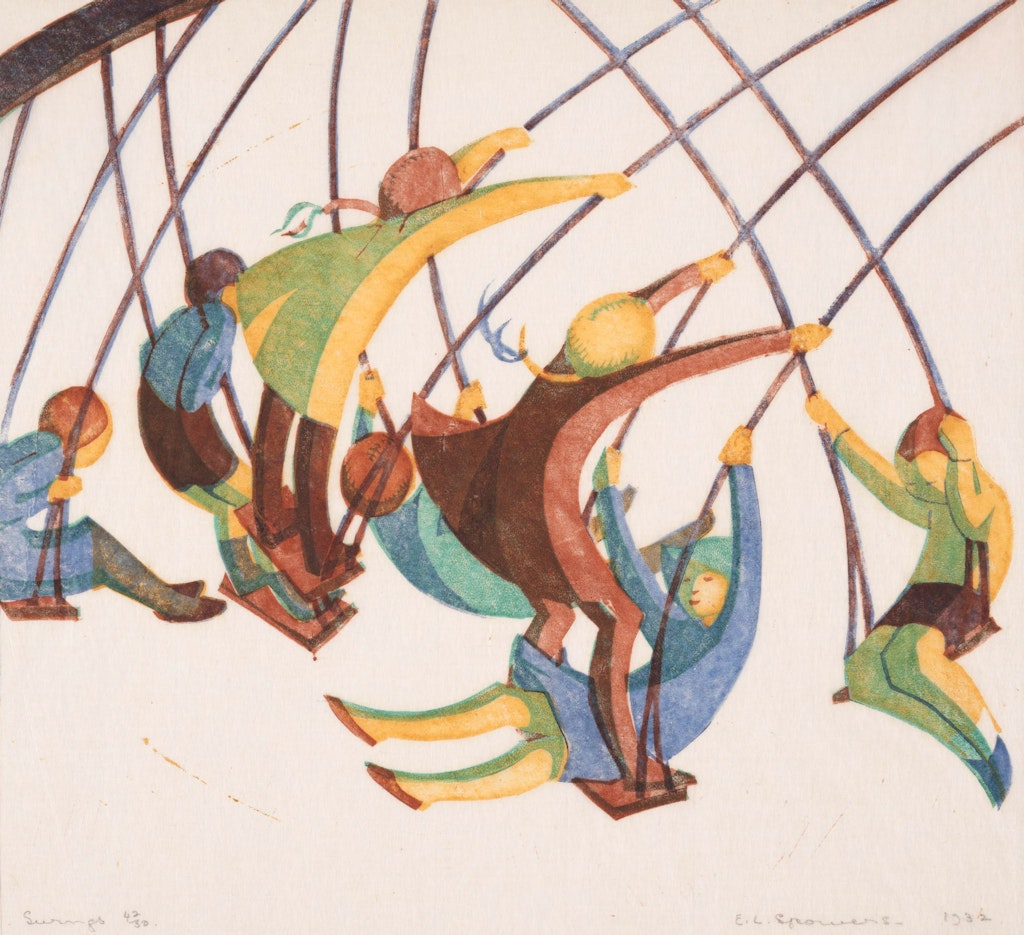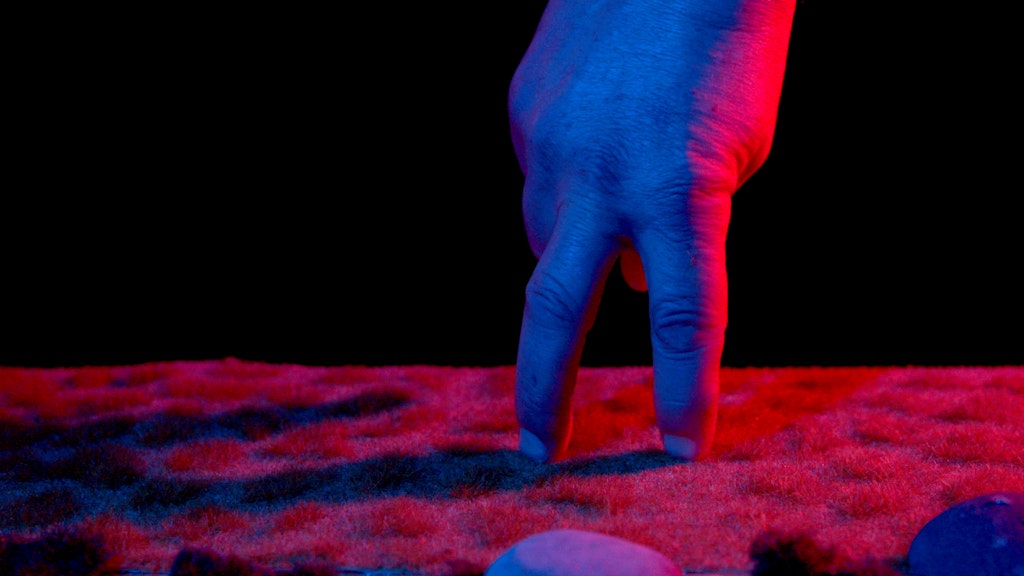The power of play

Ethel Spowers Swings 1932, Art Gallery of New South Wales
‘Play with me! Play with me!’ My four-year-old son says this constantly. Thankfully I can still muster a pretty good pirate or leopard impersonation when required, despite many years of ‘adulting’. Truth be told, until he came along, I hadn’t really thought about how fundamental play is to our development. Play for young children is as natural as breathing. The drive to test, explore, imagine and create in an open-ended way enables them to understand the world, themselves and others. But play – in all its forms – is vital for maintaining our sense of wellbeing through all stages of life (just ask Danielle Gullotta, who runs the Art and Dementia program at the Art Gallery of NSW).
The arts naturally have an enormous role in keeping the spirit of play alive in society. After all, nurturing creative thinking helps build empathy, courage, resilience and adaptability – qualities we need now more than ever. With this in mind, I delved into the Gallery’s collection to find artworks that illustrate the seven patterns of human play behaviour defined by the National Institute of Play in California. You’ll also find ideas for fun activities to try at home, no matter what your age.
With thanks to Victoria Collings from the Gallery’s Learning and Participation team for the art activities.
![Elliott Erwitt [w:289.1995[New York City]] 1953, printed 1990s, Art Gallery of New South Wales © Elliott Erwitt](https://www.datocms-assets.com/42890/1632383565-289-1995-mm.jpg?fit=clip&iptc=allow&w=1024)
Elliott Erwitt New York City 1953, printed 1990s, Art Gallery of New South Wales © Elliott Erwitt
Attunement play
Elliott Erwitt’s tender portrait of his wife and newborn daughter beautifully captures the exchange of loving eye contact that defines our earliest experiences of play. The surge of feeling between mother and child when they become ‘attuned’ through glances, facial movements and sounds is a pleasure that bears repeating again and again. All future play is built on the base formed by these precious interactions.
At home
Collect photos of your family. Can you spot any features that show you are related? Collage your photos into a display and frame them.
![Barbara Cleveland [w:380.2016[Bodies in time]] 2016, Art Gallery of New South Wales © B.C](https://www.datocms-assets.com/42890/1632383958-380-2016-still01-mm.jpg?fit=clip&iptc=allow&w=1024)
Barbara Cleveland Bodies in time 2016, Art Gallery of New South Wales © B.C
Body play and movement
Body movement lights up the brain. The benefits aren’t purely physical. Moving, acting and interacting can also accelerate learning, lift our mood and improve memory. For their work Bodies in time, Sydney collective Barbara Cleveland enlisted dancer Angela Goh to choreograph a piece that charts specific gestures from the history of dance and visual art performances. It’s an archive of bodily actions that epitomises the many ways we accumulate knowledge through movement.
At home
Listen to different types of music and invent your own joyful dance routine. Design and make a simple costume to wear for your performance.
![Mikala Dwyer [w[The divisions and subtractions]] 2017, Art Gallery of New South Wales © Mikala Dwyer. Courtesy Roslyn Oxley9 Gallery. Licensed by Copyright Agency](https://www.datocms-assets.com/42890/1632384200-2-2018-a-y-view02-mm.jpg?fit=clip&iptc=allow&w=1024)
Mikala Dwyer The divisions and subtractions 2017, Art Gallery of New South Wales © Mikala Dwyer. Courtesy Roslyn Oxley9 Gallery. Licensed by Copyright Agency
Object play
Mikala Dwyer’s The divisions and subtractions unites a menagerie of curious sculptural objects in a large open circle. The viewer is invited to enter the sacred space of the ring to draw comparisons between the scale, mass, density, transparency, colour, balance and materiality of each part. Dwyer’s installation serves as a reminder of the power of object play. We develop fine motor skills and complex problem-solving abilities when manipulating materials and objects, which leads to independent and creative thinking.
At home
Make a roller-coaster using cardboard tubes, tape and recycled materials and roll marbles or small balls through your construction.
![Kimsooja [w[Archive of mind]] 2017, Art Gallery of New South Wales © Kimsooja](https://www.datocms-assets.com/42890/1632384707-82-2018-a-s-view02-mm.jpg?fit=clip&iptc=allow&w=1024)
Kimsooja Archive of mind 2017, Art Gallery of New South Wales © Kimsooja
Social play
Social play can encompass anything from telling jokes with friends to rough-and-tumble wrestling. By playfully interacting with each other, we form strong social bonds and learn how to share, cooperate, take turns and express emotions. Kimsooja’s Archive of mind invites a quiet and meditative form of social play. An example of artists’ increasing desire to facilitate participation with their audience, it asks people to contribute to the work by rolling a sphere of clay to leave on the table. It is a collective enterprise that accumulates over time, generating a physical manifestation of our relationship between the self and others.
At home
Pretend to run a cafe in your home for your family. Set up tables and chairs, design a menu and have fun serving your guests.
![Julian Rosefeldt [w[Manifesto]] 2014-15, Art Gallery of New South Wales © Julian Rosefeldt/VG Bild-Kunst. Licensed by Copyright Agency](https://www.datocms-assets.com/42890/1632384924-235-2013-still26-mm.jpg?fit=clip&iptc=allow&w=1024)
Julian Rosefeldt Manifesto 2014-15, Art Gallery of New South Wales © Julian Rosefeldt/VG Bild-Kunst. Licensed by Copyright Agency
Imaginative and pretend play
Who better to represent our capacity for pretend play than an actor? In Julian Rosefeldt’s immersive 13-channel video installation Manifesto, Cate Blanchett assumes 12 different roles to perform monologues based on various artist manifestoes. Her embodiment of these diverse characters demonstrates how experimenting with the social and emotional aspects of life can help develop empathy. Role-playing also nurtures confidence and language skills. Blanchett’s Oscar-winning talents in that regard enabled her to use an entirely different accent for each character.
At home
Find a picture of some people in a book, magazine or online and imagine you are one of them. How would they move? What would they say? Move around as if you are that person and ask someone to guess which one you are.

Ronnie van Hout Handwalk 2015, Art Gallery of New South Wales © Ronnie van Hout
Storytelling or narrative play
Humans are storytelling machines. We tell stories every day about the world, who we are and what we do, or we create pure flights of fantasy. In the words of the National Institute of Play, stories ‘give us permission to expand our own inner stream of consciousness’. In Ronnie van Hout’s short absurdist video work Handwalk, the artist uses his own hands as proxies for actors. One hand wanders aimlessly through an alien landscape before encountering a ‘friend’. The pair touch tentatively, then dance and eventually part ways, enacting a narrative of loneliness, connection and loss.
At home
Create drawings for a comic-strip story about characters that you invent. What adventures will they have?
![Bram Bogart [w[Day-break]] 1997, Art Gallery of New South Wales © Bram Bogart/SABAM. Licensed by Copyright Agency](https://www.datocms-assets.com/42890/1632385596-418-2010-mm.jpg?fit=clip&iptc=allow&w=1024)
Bram Bogart Day-break 1997, Art Gallery of New South Wales © Bram Bogart/SABAM. Licensed by Copyright Agency
Creative play
Creative play is all about the process, not the end product. Exploring without expectation, taking risks and making mistakes lead to discovery, transformation and wisdom. Artists working in an abstract expressionist vein have perhaps taken some of the greatest risks with their chosen medium. Indulging in the sensual pleasures of colour and texture has elicited extraordinarily emotive results. Take Bram Bogart’s Day-break, for example. The simple composition of a thickly encrusted white line bisecting an equally textural vivid yellow joyfully communicates the life-affirming sensation of dawn.
At home
Make a relief sculpture using playdough or clay. Press leaves, plants or household objects into the surface to decorate it with different textures.